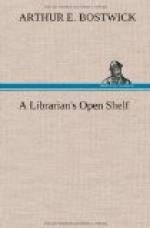Tired eyes belong, for the most part, to those who have worked them hardest; that is, to readers who have entered upon middle age or have already passed through it. At this age we become conscious that the eye is a delicate instrument—a fact which, however familiar to us in theory, has previously been regarded with aloofness. Now it comes home to us. The length of a sitting, the quality, quantity, and incidence of the light, and above all, the arrangement of the printed page, become matters of vital importance to us. A book with small print, or letters illegibly grouped, or of unrecognizable shapes, becomes as impossible to us as if it were printed in the Chinese character.
It is an unfortunate law of nature that injurious acts appear to us in their true light only after the harm is done. The burnt child dreads the fire after he has been burned—not before. So the fact that the middle-aged man cannot read small, or crooked, or badly grouped type means simply that the harmfulness of these things, which always existed for him, has cumulated throughout a long tale of years until it has obtruded itself upon him in the form of an inhibition. The books that are imperative for the tired eyes of middle age, are equally necessary for those of youth—did youth but know it. Curiously enough, we are accustomed to begin, in teaching the young to read, with very legible type. When the eyes grow stronger, we begin to maltreat them. So it is, also, with the digestive organs, which we first coddle with pap, then treat awhile with pork and cocktails, and then, perforce, entertain with pap of the second and final period. What correspond, in the field of vision, to pork and cocktails, are the vicious specimens of typography offered on all sides to readers—in books, pamphlets, magazines, and newspapers—typography that is slowly but surely ruining the eyesight of those that need it most.
Hitherto, the public librarian has been more concerned with the minds and the morals of his clientele than with that physical organism without which neither mind nor morals would be of much use. It would be easy to pick out on the shelves of almost any public library books that are a physiological scandal, printed in type that it is an outrage to place before any self-respecting reader. I have seen copies of “Tom Jones” that I should be willing to burn, as did a puritanical British library-board of newspaper notoriety. My reasons, however, would be typographic, not moral, and I might want to add




